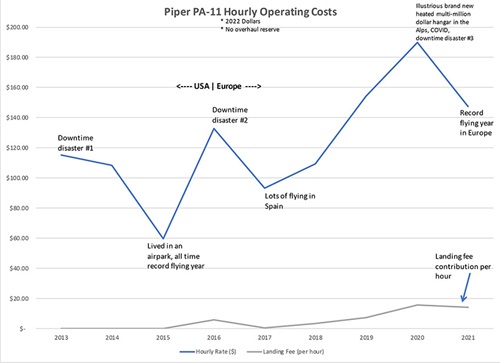How foreign flying came to feel like home
Longer legs bring lower hourly cost, enhanced enjoyment
It was during the time a few years ago that I was attempting to secure long-term hangarage in the Swiss Alps that I encountered a cynical sense of humor that later would prove illuminating when it comes to the economics of aviation.
A hangar price was quoted for the Piper PA–11, a product of a formula derived of floor square footage. The problem was that the price was unfathomably expensive, to which I replied: “You’re asking me to pay one-third of the cost of my airplane every year in hangar rent.” Without the slightest interruption, the Swiss gentleman replied, “Get a more expensive airplane.” The essence of his cynicism was, if I didn’t like the ratio of hangar rent to airplane value, I could solve it by placing a more expensive aircraft in the same rental cost. Thankfully I was able to solve the hangar rent problem by devising a solution with this individual’s successor, though it admittedly came as a surprise a few years later that there was some wisdom in the remark.
Then, 2021 marked a sea change in my European aviation adventure. I achieved the point, later in the year, where more than 50 percent of my flying hours as a pilot were in Europe. Even though I could point to a storied history of aviation since I was a kid, the fact became that more time in the sky was spent in a place that felt heinously foreign, compared to what I thought was “home.” During that year, I conquered photographing the glaciers of the Alps, and I also purchased my first foreign aircraft, a Super Cub. What is more, I hit a transition point where flying no longer felt terrifyingly foreign. While I will get more into that concept later in this article, the concept of cost still speaks loudly.

By the end of 2021 I had set a new personal record for hours flown in a year in Europe. Between the two aircraft, I clocked 255.8 hours, still short of my lifetime annual flight time record of 346.8 hours in 2015, when most of my flying was in Wyoming from an airpark. Ninety hours in 2021 came from the glacier project and 14 from ferrying the Super Cub from Norway to Switzerland. In any case, achieving a personal continental record meant that several things were functioning properly. Cost partially was one of them.
An update to the numbers shows a drop in hourly cost from the 2020 record of $203.32 to $147.70. A clear trend jumps out: The worst years are downtime disasters, whereas the best are the flying binge years. In fact, the three cost troughs are the three highest flying years in my personal history.
At the same token, $147.70 is a far cry from $59.64. What comprises the difference? It is tempting to hurl a torrent of abuses at the European system, though one key reality stands out between both years: the choice of hangar. In Wyoming, I was renting an airpark home with a hangar included for no additional cost, at the tail end of Jackson Hole’s Great Recession real estate hangover. It was very inexpensive at the time. At present, I house the PA–11 in an illustrious high-end heated throne with a $1.5 million turntable that spins jets. The rent alone adds almost $40 per hour to operating costs. At the time of signing the contract, I couldn’t believe that I was allowing myself to spend the money, though for comparison’s sake at one point during the earlier half of COVID-19, I considered moving back to Wyoming. The only hangar rental I could find at the same airpark was a small space behind a bunch of large aircraft in a shared hangar, and it would cost 50 percent more than my avant-garde Swiss hangar. Costs in the United States have gone up dramatically in the interim to the point that I am quite happy where I am.
Adjusting Wyoming’s costs to include a Swiss hangar lands Wyoming at $99 per hour, with Switzerland at $147, both in good flying years. The net result of a 50-percent increase for European flying is consistent with reality as purchases are made. Categories are as follows:
- Fuel: Two to 2.5 times higher.
- Maintenance labor: 20 percent higher.
- Parts: 20 percent higher (VAT and shipping).
- Insurance: 15 percent lower.
- Hangar: 10 percent lower (average).
- Landing fees: $3,116.84 for 156 landings in 2021 ($19.97 average).
- “User fees”: Negligible.
It is my personal view that cost is the less irritating component of European flying, as a web of variable rules and procedures, which are often nonfinancial, contributes to the most anxiety, reticence, and eventual reduction in flights taken. For me, if the contingencies stack upon each other and get too complicated, then I am prone to just take a local flight instead.
That concept segues into data that came to light in early 2021, after five years of flying in Europe. I had sensed that I wasn’t landing at non-base airports very often, owing to a fear and concern over burdensome rules. I collated data, made a chart, and the result was yet another perception of a runaway train: The move to Europe resulted in a continuous increase in flights that originated and ended at the home airport. Coinciding with a record-high hourly cost in 2020 was an unfortunate concentration of local flights: 93 percent of those flights didn’t land at another airport. Both factors were not pointing to a bright future at the time, though 2021 was a welcome reversal. Similar to how costs partially normalized, 2021 was the first year where my flight ratios resembled flying in the United States.
Nearly a decade before, the pattern was different: 2010 to 2013 came as close as ever to what I consider “normal” Cub flying—the door open on hot evenings in North Carolina, local flights mixed with random $100 hamburger runs to other airports. The result, not by plan, was a classic 50/50 mix of local and cross-country. That altered dramatically in 2014, when I crossed the country in a series of aggressive adventures, which were related to the commencement of my aerial photography pursuits. While one could argue that such a use of a PA–11 is not normal, I was and am still trying to do the same sense of adventuring during my years in Europe and, as time went by, the wheels were coming off the process all the way through 2020, until they were solved in 2021.
What solved the problem?

I faced a critical point in late winter of 2021, where I realized it was time to get over my fear of other airports. Rules, procedures, and requirements were very real: There was often an approval required, limited hours of operation, lack of fuel, or another concern that truly either made it challenging, rendered it pointless to land there, or simply took the joy out of Cub flying. While I love to make up my mind in the air where I am going, it was time to teach myself the only flying that could be done in Europe … which is how Europeans do it.
The fears abated once I started the very basic process of landing at airports between 50 and 100 miles away. Even if I didn’t need fuel and could have done the flight without the stop, I made a point to methodically experience each of these different places. What I found was that the rules and procedures aren’t as restrictive as they seemed; much more flexibility was built into the system than was apparent on paper. What then began as a training and desensitizing experience transitioned into something of a fun exercise: Where could I land that I have not before? Those words sound much closer to Cub flying a decade ago during warm Carolina evenings and are indeed as fulfilling as they used to be.
What is very interesting to me is that the feeling of being in a foreign location, far from home, where things were doomed to fail, completely evaporated once I got comfortable with other airports. Up until the winter of 2021, I felt myself having these sort of out-of-body thoughts, when returning to the airport after a stunning flight in the Alps, that I was practically off the end of the earth, with the whole plan held together by a shoestring, owing to unfamiliarity. I had a conversation with a fellow pilot from Australia who has been living in Europe much longer than I have, who keeps an aircraft here as well. He noted that it took him many more years before he could dispense with the feelings that it was all about to collapse at any time. At least I wasn’t alone with the sentiment.
The numbers tell the same story as the experience on the ground and in the air. While hourly costs are roughly 50 percent higher—which is no small amount, though not necessarily enough to entirely ruin aviation—it is the unfamiliarity of the process, cultures, and airport network that was the hardest part to adjust to. At this point, landing at new locations has become part of my normal flying routine; I am simply less interested in local flying, even if it is easier. While it was a significant hurdle to restore the old American mentality in a new land in new conditions, none of the changes in 2021 addressed the idea of flying significant distances, another American pastime.
This is still a work in progress.




